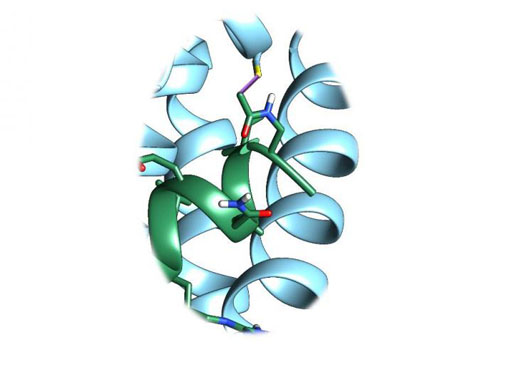Development of Anti-Cancer Drugs May Overlook Compounds Useful for Humans
By LabMedica International staff writers
Posted on 21 Dec 2016
A large proportion of cancer research is done with mouse models; however a recent paper suggested that differences between the mouse and human genomes may lead to promising approaches to curing the disease in humans being overlooked.Posted on 21 Dec 2016
Work done with mice has revealed that upregulation of anti-apoptotic (anti-death) Bcl-2 proteins in certain tumors confers cancer cell resistance to chemotherapy or radiation. Members of the anti-apoptotic Bcl-2 proteins, including Bcl-2, Mcl-1, Bcl-xL, Bcl-W, and Bfl-1 inhibit apoptosis by selectively binding to conserved alpha-helical regions, named BH3 domains, of pro-apoptotic proteins such as Bim, tBid, Bad, or NOXA (Phorbol-12-myristate-13-acetate-induced protein 1).

Image: A structural model of Bfl-1 (light blue ribbon with yellow stick representing a sulfur atom) in complex with the inhibitor 130G4 (green ribbon with red, oxygen, and blue, nitrogen, sticks). The bond between the Bfl-1 sulfur atom (yellow) and 130G4 is highlighted by a magenta stick (Photo courtesy of Pellecchia laboratory, University of California, Riverside).
Five anti-apoptotic proteins have been identified that interact with various degrees of selectivity with BH3 containing pro-apoptotic counterparts. Cancer cells present various and variable levels of these proteins, making it difficult to design therapeutic drugs to promote apoptosis. Recently, BH3 profiling was introduced as a method to classify cancer cells based on their ability to resist apoptosis following exposure to selected BH3 peptides. However, these studies were based on binding affinities measured with model BH3 peptides and Bcl-2-proteins taken from mouse sequences.
Investigators at the University of California, Riverside (USA) wrote in the November 18, 2016, online edition of the journal ACS Chemical Biology that while the majority of these interactions were conserved between mice and humans, they found surprisingly that human NOXA bound to human Bfl-1 potently and covalently via conserved cysteine residues, with over two orders of magnitude increased affinity over Mcl-1. This finding suggested that some assumptions of the original BH3 profiling should be revisited and that perhaps further targeting efforts should be redirected towards Bfl-1, for which no suitable specific inhibitors or pharmacological tools have been reported.
"What we discovered is that while these early studies done with the mouse versions of the proteins NOXA, Mcl-1, and Bfl-1 were correct, these do not entirely apply to human proteins," said senior author Dr. Maurizio Pellecchia, professor of biomedical sciences at the University of California, Riverside. "This is because human NOXA and Bfl-1 are different from their mouse counterparts. Indeed, we found that when we profiled human NOXA against human anti-apoptotic proteins, the highest affinity was for Bfl-1, and not for Mcl-1, making Bfl-1 a much more relevant drug target than previously assumed."
"Academics and pharmaceutical companies are spending considerable amount of effort and resources in finding antagonists to Mcl-1," said Dr. Pellecchia. "While these agents are surely useful in certain conditions that are exacerbated by over-production of Mcl-1, we have shown that more focus on Bfl-1 is warranted. Our research provides new insights on the mechanisms of cancer resistance to chemotherapy, suggesting Bfl-1 as a viable drug target, and also provides a direct path on how to develop Bfl-1-targeting drugs."
Related Links:
University of California, Riverside








 (3) (1).png)





